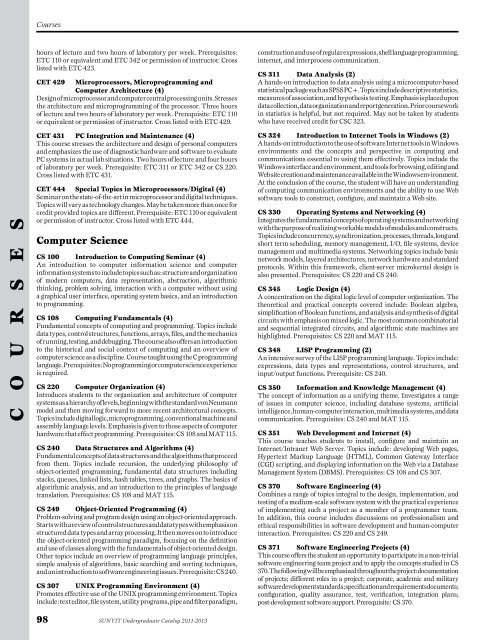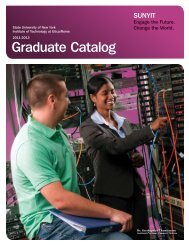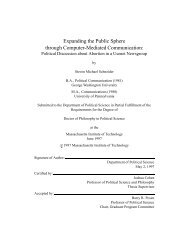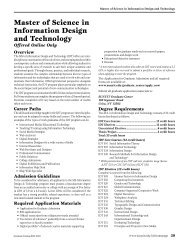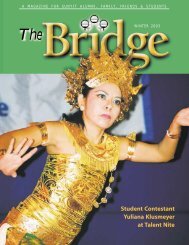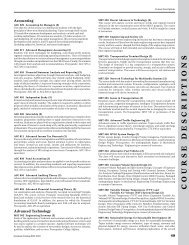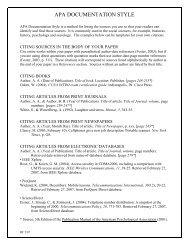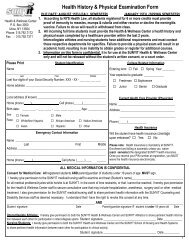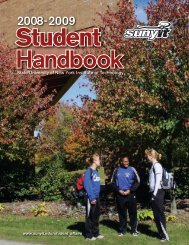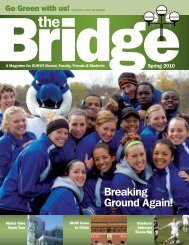Undergraduate Catalog 2011-2013 - SUNY Institute of Technology
Undergraduate Catalog 2011-2013 - SUNY Institute of Technology
Undergraduate Catalog 2011-2013 - SUNY Institute of Technology
Create successful ePaper yourself
Turn your PDF publications into a flip-book with our unique Google optimized e-Paper software.
Courses<br />
hours <strong>of</strong> lecture and two hours <strong>of</strong> laboratory per week. Prerequisites:<br />
ETC 110 or equivalent and ETC 342 or permission <strong>of</strong> instructor. Cross<br />
listed with ETC 423.<br />
CET 429 Microprocessors, Microprogramming and<br />
Computer Architecture (4)<br />
Design <strong>of</strong> microprocessor and computer central processing units. Stresses<br />
the architecture and microprogramming <strong>of</strong> the processor. Three hours<br />
<strong>of</strong> lecture and two hours <strong>of</strong> laboratory per week. Prerequisite: ETC 110<br />
or equivalent or permission <strong>of</strong> instructor. Cross listed with ETC 429.<br />
construction and use <strong>of</strong> regular expressions, shell language programming,<br />
internet, and interprocess communication.<br />
CS 311 Data Analysis (2)<br />
A hands-on introduction to data analysis using a microcomputer-based<br />
statistical package such as SPSS PC+. Topics include descriptive statistics,<br />
measures <strong>of</strong> association, and hypothesis testing. Emphasis is placed upon<br />
data collection, data organization and report generation. Prior coursework<br />
in statistics is helpful, but not required. May not be taken by students<br />
who have received credit for CSC 323.<br />
C O U R S E S<br />
CET 431 PC Integration and Maintenance (4)<br />
This course stresses the architecture and design <strong>of</strong> personal computers<br />
and emphasizes the use <strong>of</strong> diagnostic hardware and s<strong>of</strong>tware to evaluate<br />
PC systems in actual lab situations. Two hours <strong>of</strong> lecture and four hours<br />
<strong>of</strong> laboratory per week. Prerequisite: ETC 311 or ETC 342 or CS 220.<br />
Cross listed with ETC 431.<br />
CET 444 Special Topics in Microprocessors/Digital (4)<br />
Seminar on the state-<strong>of</strong>-the-art in microprocessor and digital techniques.<br />
Topics will vary as technology changes. May be taken more than once for<br />
credit provided topics are different. Prerequisite: ETC 110 or equivalent<br />
or permission <strong>of</strong> instructor. Cross listed with ETC 444.<br />
Computer Science<br />
CS 100 Introduction to Computing Seminar (4)<br />
An introduction to computer information science and computer<br />
information systems to include topics such as: structure and organization<br />
<strong>of</strong> modern computers, data representation, abstraction, algorithmic<br />
thinking, problem solving, interaction with a computer without using<br />
a graphical user interface, operating system basics, and an introduction<br />
to programming.<br />
CS 108 Computing Fundamentals (4)<br />
Fundamental concepts <strong>of</strong> computing and programming. Topics include<br />
data types, control structures, functions, arrays, files, and the mechanics<br />
<strong>of</strong> running, testing, and debugging. The course also <strong>of</strong>fers an introduction<br />
to the historical and social context <strong>of</strong> computing and an overview <strong>of</strong><br />
computer science as a discipline. Course taught using the C programming<br />
language. Prerequisites: No programming or computer science experience<br />
is required.<br />
CS 220 Computer Organization (4)<br />
Introduces students to the organization and architecture <strong>of</strong> computer<br />
systems as a hierarchy <strong>of</strong> levels, beginning with the standard von Neumann<br />
model and then moving forward to more recent architectural concepts.<br />
Topics include digital logic, microprogramming, conventional machine and<br />
assembly language levels. Emphasis is given to those aspects <strong>of</strong> computer<br />
hardware that effect programming. Prerequisites: CS 108 and MAT 115.<br />
CS 240 Data Structures and Algorithms (4)<br />
Fundamental concepts <strong>of</strong> data structures and the algorithms that proceed<br />
from them. Topics include recursion, the underlying philosophy <strong>of</strong><br />
object-oriented programming, fundamental data structures including<br />
stacks, queues, linked lists, hash tables, trees, and graphs. The basics <strong>of</strong><br />
algorithmic analysis, and an introduction to the principles <strong>of</strong> language<br />
translation. Prerequisites: CS 108 and MAT 115.<br />
CS 249 Object-Oriented Programming (4)<br />
Problem-solving and program design using an object-oriented approach.<br />
Starts with a review <strong>of</strong> control structures and data types with emphasis on<br />
structured data types and array processing. It then moves on to introduce<br />
the object-oriented programming paradigm, focusing on the definition<br />
and use <strong>of</strong> classes along with the fundamentals <strong>of</strong> object-oriented design.<br />
Other topics include an overview <strong>of</strong> programming language principles,<br />
simple analysis <strong>of</strong> algorithms, basic searching and sorting techniques,<br />
and an introduction to s<strong>of</strong>tware engineering issues. Prerequisite: CS 240.<br />
CS 307 UNIX Programming Environment (4)<br />
Promotes effective use <strong>of</strong> the UNIX programming environment. Topics<br />
include: text editor, file system, utility programs, pipe and filter paradigm,<br />
CS 324 Introduction to Internet Tools in Windows (2)<br />
A hands-on introduction to the use <strong>of</strong> s<strong>of</strong>tware Internet tools in Windows<br />
environments and the concepts and perspective in computing and<br />
communications essential to using them effectively. Topics include the<br />
Windows interface and environment, and tools for browsing, editing and<br />
Web site creation and maintenance available in the Windows environment.<br />
At the conclusion <strong>of</strong> the course, the student will have an understanding<br />
<strong>of</strong> computing communication environments and the ability to use Web<br />
s<strong>of</strong>tware tools to construct, configure, and maintain a Web site.<br />
CS 330 Operating Systems and Networking (4)<br />
Integrates the fundamental concepts <strong>of</strong> operating systems and networking<br />
with the purpose <strong>of</strong> realizing workable models <strong>of</strong> modules and constructs.<br />
Topics include concurrency, synchronization, processes, threads, long and<br />
short term scheduling, memory management, I/O, file systems, device<br />
management and multimedia systems. Networking topics include basic<br />
network models, layered architectures, network hardware and standard<br />
protocols. Within this framework, client-server microkernel design is<br />
also presented. Prerequisites: CS 220 and CS 240.<br />
CS 345 Logic Design (4)<br />
A concentration on the digital logic level <strong>of</strong> computer organization. The<br />
theoretical and practical concepts covered include: Boolean algebra,<br />
simplification <strong>of</strong> Boolean functions, and analysis and synthesis <strong>of</strong> digital<br />
circuits with emphasis on mixed logic. The most common combinatorial<br />
and sequential integrated circuits, and algorithmic state machines are<br />
highlighted. Prerequisites: CS 220 and MAT 115.<br />
CS 348 LISP Programming (2)<br />
An intensive survey <strong>of</strong> the LISP programming language. Topics include:<br />
expressions, data types and representations, control structures, and<br />
input/output functions. Prerequisite: CS 240.<br />
CS 350 Information and Knowledge Management (4)<br />
The concept <strong>of</strong> information as a unifying theme. Investigates a range<br />
<strong>of</strong> issues in computer science, including database systems, artificial<br />
intelligence, human-computer interaction, multimedia systems, and data<br />
communication. Prerequisites: CS 240 and MAT 115.<br />
CS 351 Web Development and Internet (4)<br />
This course teaches students to install, configure and maintain an<br />
Internet/Intranet Web Server. Topics include: developing Web pages,<br />
Hypertext Markup Language (HTML), Common Gateway Interface<br />
(CGI) scripting, and displaying information on the Web via a Database<br />
Management System (DBMS). Prerequisites: CS 108 and CS 307.<br />
CS 370 S<strong>of</strong>tware Engineering (4)<br />
Combines a range <strong>of</strong> topics integral to the design, implementation, and<br />
testing <strong>of</strong> a medium-scale s<strong>of</strong>tware system with the practical experience<br />
<strong>of</strong> implementing such a project as a member <strong>of</strong> a programmer team.<br />
In addition, this course includes discussions on pr<strong>of</strong>essionalism and<br />
ethical responsibilities in s<strong>of</strong>tware development and human-computer<br />
interaction. Prerequisites: CS 220 and CS 249.<br />
CS 371 S<strong>of</strong>tware Engineering Projects (4)<br />
This course <strong>of</strong>fers the student an opportunity to participate in a non‐trivial<br />
s<strong>of</strong>tware engineering team project and to apply the concepts studied in CS<br />
370. The following will be emphasized throughout the project: documentation<br />
<strong>of</strong> projects; different roles in a project; corporate, academic and military<br />
s<strong>of</strong>tware development standards; specification and requirements documents;<br />
configuration, quality assurance, test, verification, integration plans;<br />
post‐development s<strong>of</strong>tware support. Prerequisite: CS 370.<br />
98 <strong>SUNY</strong>IT <strong>Undergraduate</strong> <strong>Catalog</strong> <strong>2011</strong>-<strong>2013</strong>


